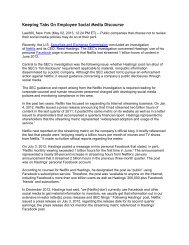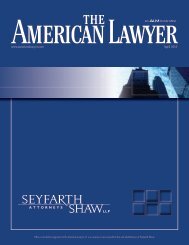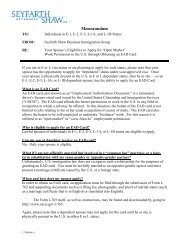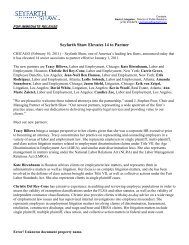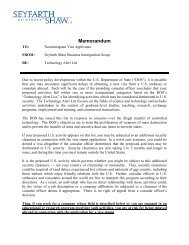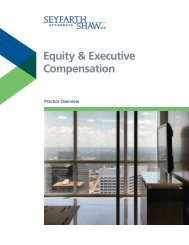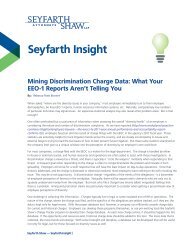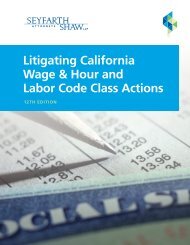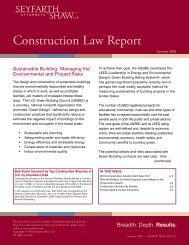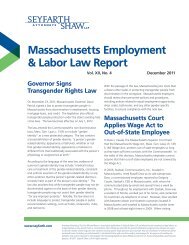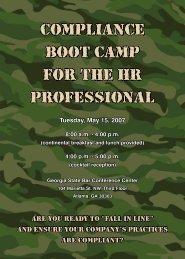Dollars and Jobs for EB-5 Green Cards - Seyfarth Shaw LLP
Dollars and Jobs for EB-5 Green Cards - Seyfarth Shaw LLP
Dollars and Jobs for EB-5 Green Cards - Seyfarth Shaw LLP
Create successful ePaper yourself
Turn your PDF publications into a flip-book with our unique Google optimized e-Paper software.
<strong>Dollars</strong> <strong>and</strong> <strong>Jobs</strong> <strong>for</strong> <strong>EB</strong>-5 <strong>Green</strong> <strong>Cards</strong>:<br />
A Challenging Route to U.S. Residency<br />
By Angelo A. Paparelli <strong>and</strong> Ted J. Chiappari *<br />
The <strong>EB</strong>-5 employment-creation immigrant visa category -- which promises a green card if a<br />
<strong>for</strong>eigner invests $500,000 or $1 million earmarked to create 10 U.S. jobs -- has at times<br />
appeared to be a bureaucratic mashup of Let’s Make a Deal <strong>and</strong> The Price is Right. 1 The coveted<br />
green card looms as the showcased prize in the background, with government officials <strong>and</strong> cashhungry<br />
private-sector developers playing Bob Barker <strong>and</strong> Monty Hall, asking the <strong>for</strong>eign investor<br />
“contestant” to put up big bucks in advance <strong>for</strong> the privilege of choosing one of numerous<br />
investment opportunities obscured behind closed “doors.” Un<strong>for</strong>tunately, game shows have<br />
losers, <strong>and</strong> these <strong>for</strong>eign investors often find themselves poorer, no wiser <strong>and</strong> without legal<br />
immigration status in the United States.<br />
As American legend Homer Simpson reminds us in remarking on the adage, a fool <strong>and</strong> his<br />
money are soon parted, “I would pay anyone a lot of money to explain that to me.” 2 The authors<br />
are hopeful that this article, provided gratis, will shed light on recent developments that promise to<br />
make the <strong>EB</strong>-5 program less a game of chance <strong>and</strong> more an exercise in intelligent green-card<br />
procurement.<br />
Investment in Job Creation<br />
The investor visa category has gone through dramatic changes over the years. Until 1976, an<br />
immigration regulation, 8 C.F.R. § 212.8(b)(4), offered a green card to <strong>for</strong>eign citizens who<br />
invested or were actively in the process of investing into a commercial or agricultural enterprise a<br />
mere $10,000 ($40,330 in 2012 dollars). Today, however, U.S. immigration laws favor high-dollar<br />
investors who lay down at least $500,000 or $1 million to become job creators.<br />
The new visas-<strong>for</strong>-dollars deal began with the Immigration Act of 1990. Despite claims that the<br />
<strong>EB</strong>-5 was a ploy allowing <strong>for</strong>eigners to “buy” U.S. citizenship, Congress decided that up to 10,000<br />
<strong>for</strong>eign investors per year (including one’s spouse <strong>and</strong> minor children) could gain a green card in<br />
a two-step sequence over at least two years. This process, which is still in place today, requires<br />
the noncitizen to invest or be actively proceeding to invest at least $1,000,000 in lawfully attained<br />
funds to establish a “new commercial enterprise” or invest in a “troubled business” that directly<br />
1 For background on these time-honored American TV game shows, see:<br />
http://en.wikipedia.org/wiki/The_Price_Is_Right_(1956_U.S._game_show <strong>and</strong><br />
http://en.wikipedia.org/wiki/Let%27s_Make_a_Deal. (All links current as of August 15, 2012)<br />
2 John Frink <strong>and</strong> Don Payne, “Homer Simpson: What I’ve Learned,” Esquire Magazine, Jan. 10, 2010,<br />
accessible at http://www.esquire.com/features/what-ive-learned/ESQ0102-JAN_HOMER.<br />
© 2012 <strong>Seyfarth</strong> <strong>Shaw</strong> <strong>LLP</strong> | www.seyfarth.com | 1
employs ten U.S. citizens (none of whom may be close relatives of the investor) on a full time<br />
basis within two years or in a reasonable time thereafter. A lesser sum, $500,000, can be<br />
invested if the job-creating business activity is located in “targeted employment areas” – locales<br />
suffering unemployment at 150% of the national average – or in rural areas.<br />
If the petition is approved, the investor <strong>and</strong> the immediate family may then apply <strong>for</strong> an immigrant<br />
visa or adjustment of status in order to be granted “conditional” permanent residence. Be<strong>for</strong>e the<br />
two-year anniversary of conditional residence, however, the investor must submit a petition to<br />
remove conditions <strong>and</strong> show that the full amount of the required funds had in fact been invested<br />
(“sustained”) in the business <strong>and</strong> that the ten jobs had been created during the two-years of the<br />
investor’s conditional residency or will be created in a reasonable time thereafter. If the second<br />
petition is approved, then green card status becomes unassailable, or, so to speak, truly <strong>and</strong><br />
undeniably permanent.<br />
In the early 1990s, the employment creation category was rarely used, so the U.S. government<br />
took added steps to encourage participation. At the administrative level, the immigration agency<br />
in<strong>for</strong>mally loosened the requirements to make the program more user-friendly, <strong>and</strong> that caused<br />
fraud schemes to flourish. In 1998, the government clamped down with a heavy h<strong>and</strong>, <strong>and</strong> wellpublicized<br />
denials followed by protracted litigation <strong>and</strong> uncertainty made the program unattractive<br />
again.<br />
At the same time, Congress in 1993 created a pilot program – essentially a second, parallel<br />
program - allowing “regional centers” – entities authorized by the immigration authorities to accept<br />
investors’ funds in return <strong>for</strong> a qualified promise by the center to create the ten jobs per investor<br />
directly or indirectly. The most important difference with the pilot program is the less challenging<br />
job-creation st<strong>and</strong>ard wherein jobs created indirectly across one or more geographic areas <strong>and</strong><br />
industries can be calculated in theory without the need to identify the actual jobs or workers in<br />
such jobs. Moreover, as a practical matter, virtually all regional centers are in targeted<br />
employment areas, so the de facto investment threshold is $500,000, rather than $1,000,000.<br />
New Life <strong>for</strong> the Program<br />
The regional centers have breathed new life into the <strong>EB</strong>-5 program. The USCIS Office of<br />
Per<strong>for</strong>mance <strong>and</strong> Quality, Data Analysis <strong>and</strong> Reporting Branch, reports that in recent years the<br />
approval rate <strong>for</strong> initial investor petitions (Form I-526) have ranged from approval of 53% of all I-<br />
526 applicants in FY 2005 to approval of 79% in FY 2012, <strong>and</strong> petitions to remove conditions on<br />
residence (Form I-829) have been approved at a rate of 62% of all I-829 petitioners (FY 2005) to<br />
94% of all I-829 petitioners. 3 This recent trend of increased approval rates is a direct result of the<br />
USCIS’s greater confidence in its ability to regulate regional centers <strong>and</strong> adjudicate petitions by<br />
investors in those centers.<br />
3 See April 23, 2012 Report, updated July 19, 2012, U.S. Citizenship <strong>and</strong> Immigration Services, “Immigrant<br />
Petition by Alien Entrepreneur (I-526) <strong>and</strong> Petition by Entrepreneur to Remove Conditions (I-829) Servicewide<br />
Receipts, Approvals, Denials, Fiscal Year(s): 2005 - 2012 (3rd Quarter).” Copy on file with the authors.<br />
© 2012 <strong>Seyfarth</strong> <strong>Shaw</strong> <strong>LLP</strong> | www.seyfarth.com | 2
Alas, the <strong>EB</strong>-5 regional center program has in some ways become a victim of its own success.<br />
As dem<strong>and</strong> <strong>for</strong> employment creation visas has risen, both because of the perceived relative ease<br />
of obtaining the green card through investment <strong>and</strong> because of the substantial delays, particularly<br />
<strong>for</strong> persons born in China or India, in obtaining the green card through an employer-sponsored<br />
visa, once again abusive <strong>and</strong> fraudulent investment schemes have flourished. Perceived fraud<br />
<strong>and</strong> abuse have led USCIS to tighten up its adjudications once again, resulting in an increase in<br />
requests <strong>for</strong> evidence, denials <strong>and</strong> there<strong>for</strong>e uncertainty <strong>for</strong> <strong>for</strong>eign investors.<br />
To its credit, USCIS is now “actively in the process” of introducing a number of quality<br />
enhancements to its oversight <strong>and</strong> administration of the visa category, as reported in this July 18,<br />
2012 “Message from Alej<strong>and</strong>ro N. Mayorkas,” 4 its Director:<br />
The <strong>EB</strong>-5 program has spurred the creation of tens of thous<strong>and</strong>s of new jobs <strong>and</strong> the<br />
Injection of billions of dollars into the U.S. economy since Congress created the program<br />
in 1990. Interest in the <strong>EB</strong>-5 program has grown exponentially in recent years, both from<br />
domestic project developers seeking capital <strong>and</strong> <strong>for</strong>eign investors who have the capital<br />
that can fuel economic growth. USCIS has met this unprecedented growth <strong>and</strong> interest<br />
with a corresponding dedication of resources. … Since 2009, we have quadrupled the<br />
size of the <strong>EB</strong>-5 adjudications team <strong>and</strong> brought on board eight expert economists<br />
dedicated to the <strong>EB</strong>-5 program to ensure that <strong>EB</strong>-5 cases are h<strong>and</strong>led expeditiously <strong>and</strong><br />
with appropriate expertise. In the next month, two full-time attorneys with substantial<br />
transactional experience will enter on duty as new additions to the USCIS <strong>EB</strong>-5 program<br />
team. And by the end of July, a special Review Board consisting of two Supervisory<br />
Immigration Services Officers <strong>and</strong> one economist will review every pending application<br />
<strong>for</strong> regional center designation <strong>for</strong> which a denial has been recommended, with<br />
applicants receiving the opportunity to discuss their cases in-person be<strong>for</strong>e any final<br />
adverse decision is rendered…<br />
[In addition,] the new office will be led by a new Chief of Immigrant Investor Programs …<br />
[who] will have significant experience in the business world <strong>and</strong> will assume responsibility<br />
<strong>for</strong> ensuring that the program is administered efficiently, with integrity, with predictability,<br />
<strong>and</strong> with an underst<strong>and</strong>ing of today’s business realities.<br />
The announcement of USCIS program enhancements, including the creation of a regional center<br />
Review Board, the employment of eight economists, the anticipated recruitment <strong>and</strong> appointment<br />
of a new Chief of Immigrant Investor Programs, <strong>and</strong> the hiring of attorneys with transactional<br />
experience, cannot come soon enough <strong>for</strong> would-be <strong>EB</strong>-5 applicants. 5 There are now 226<br />
4 Copy of “Message from Alej<strong>and</strong>ro N. Mayorkas,” an email from the USCIS Office of Public Engagement,<br />
on file with the authors, also accessible at: http://www.aila.org/content/default.aspx?docid=40574 .<br />
5 This is somewhat of a “Back to the Future” moment. The new “Chief of Immigrant Investor Programs”<br />
sounds very familiar to the old “Foreign Trade, Investment <strong>and</strong> Regional Center Program” (FTIRCP) office<br />
© 2012 <strong>Seyfarth</strong> <strong>Shaw</strong> <strong>LLP</strong> | www.seyfarth.com | 3
USCIS-approved Regional Centers 6 in which to entrust invested capital, <strong>and</strong> countless more<br />
designation requests in process. Some investments have failed or gone belly up, <strong>and</strong> in a few<br />
recent regional center situations, unscrupulous scam artists, taking little heed of U.S. <strong>and</strong> <strong>for</strong>eign<br />
securities laws, 7 have fleeced investors in both sunny <strong>and</strong> rainy times, as one commenter 8 has<br />
noted:<br />
[The <strong>EB</strong>-5] program is so rife with fraud <strong>and</strong> corruption that it could actually have the<br />
opposite impact [of creating jobs] <strong>and</strong> deter[ing] investment. To regain its credibility, the<br />
program must make a number of changes to enable more transparency <strong>and</strong> dem<strong>and</strong><br />
more competence from its operators. . . .<br />
Many investments have failed to create the required 10 jobs <strong>and</strong> even gone bankrupt,<br />
leaving the investor without his money or his green card.<br />
While many <strong>EB</strong>-5 regional centers have solid records, a disturbing number have directed<br />
investor money to risky projects <strong>and</strong> companies that pay little to no return, overseen by<br />
brokers who get a commission regardless of how the investment plays out.<br />
Aside from accusations of outright fraud, there is also a clear lack of underst<strong>and</strong>ing among<br />
government administrators about how to manage an investment program.<br />
that was working relatively well until it was unceremoniously abolished in December 2009. The main<br />
innovation of the “Chief of Immigrant Investor Programs” appears to be the creation of the “special Review<br />
Board,” an idea first floated over a year ago when USCIS disclosed it was considering implementing<br />
“Premium Processing” (expedited adjudication) of <strong>EB</strong>-5 matters. The “Premium Processing” initiative seems<br />
to have faded away, but the “special Review Board” idea has survived. See, January 19, 2005<br />
Memor<strong>and</strong>um of William Yates, USCIS Associate Director of Operations, “Establishment of an Investor <strong>and</strong><br />
Regional Center Unit,” HQPRD 70/6.2.8, accessible at: http://1.usa.gov/MgbmHS, <strong>and</strong> December 11, 2009,<br />
Memor<strong>and</strong>um of Donald Neufeld, USCIS Associate Director of Operations, “Adjudication of <strong>EB</strong>-5 Regional<br />
Center Proposals <strong>and</strong> Affiliated Form I-526 <strong>and</strong> Form I-829 Petitions; Adjudicators Field Manual (AFM)<br />
Update to Chapters 22.4 <strong>and</strong> 25.2 (AD09-38),” HQ 70/6.2, AD 09-38, accessible at:<br />
http://1.usa.gov/OZMze4.<br />
6 The USCIS makes the list available online at: http://1.usa.gov/O70FtT.<br />
7 For background on securities law issues in the <strong>EB</strong>-5 context, see Jennifer Mercier Moseley, Angelo A.<br />
Paparelli, Ladd W. Mark <strong>and</strong> Carolyn Lee, “The Relevance Of U.S. Securities Laws To Immigrant Investors,<br />
<strong>EB</strong>-5 Regional Centers And Their Advisors,” 14 Bender's Immigration Bulletin 938 (Aug. 1, 2009), accessible<br />
at: http://bit.ly/OPgEgj.<br />
8 Ann Lee, “Making Visas-<strong>for</strong>-<strong>Dollars</strong> Work,” New York Times, April 16, 2012, p. A19, accessible at:<br />
http://nyti.ms/HLLrdx. Similarly, see, James Kelleher, Karin Matz <strong>and</strong> Melanie Lee, “Special report:<br />
Overselling the American dream overseas,” Reuters, Dec. 22, 2010, available at: http://reut.rs/gFpylv.<br />
© 2012 <strong>Seyfarth</strong> <strong>Shaw</strong> <strong>LLP</strong> | www.seyfarth.com | 4
Looking Ahead<br />
Although the regional center program has strengthened the <strong>EB</strong>-5 category, the program faces a<br />
sunset on September 30, 2012 -- one of several since its creation in 1993. Fortunately, a bill to<br />
reauthorize the <strong>EB</strong>-5 regional center program, S. 3245, 9 recently passed the Senate, <strong>and</strong><br />
prospects <strong>for</strong> House passage are promising. 10<br />
Still, reauthorization of the regional center program by itself is insufficient. The government<br />
immigration agencies, especially USCIS, must do more than follow Director Mayorkas’s m<strong>and</strong>ate<br />
<strong>for</strong> the new <strong>EB</strong>-5 program chief. It is not enough merely to ensure “that the program is<br />
administered efficiently, with integrity, with predictability, <strong>and</strong> with an underst<strong>and</strong>ing of today’s<br />
business realities.” USCIS must publish proposed <strong>EB</strong>-5 regulations <strong>for</strong> public comment <strong>and</strong> then<br />
issue final rules that “maintain the integrity of the category yet are faithful to its legislative text,<br />
history <strong>and</strong> purpose, <strong>and</strong> are applied with consistent st<strong>and</strong>ards of interpretation.” 11<br />
Prospective immigrant investors should of course also take heed of a foundational principle of<br />
Anglo-American law, caveat emptor (buyer beware) when considering investment opportunities<br />
<strong>and</strong> the wisdom of entrusting one’s future to the vagaries of an inconsistently adjudicated<br />
process. Clearly, the employment-creation immigrant visa program should be administered in<br />
such a way that prospective immigrants will likewise trust in another bedrock precept of Anglo-<br />
American jurisprudence, the rule of law. 12<br />
Angelo A. Paparelli is a partner at <strong>Seyfarth</strong> <strong>Shaw</strong> in New York <strong>and</strong> Los Angeles. Ted J.<br />
Chiappari is a partner at Satterlee Stephens Burke & Burke in New York. Olivia M. Sanson, an<br />
associate at Satterlee Stephens, assisted in the preparation of this article<br />
Reprinted with permission from the August 22, 2012 edition of the New York Law Journal.<br />
© 2010 ALM Properties Inc. All rights reserved. Further duplication without permission is<br />
prohibited. The authors thank the Journal <strong>for</strong> permission to reprint this article<br />
9 S. 3245 -- which also extends other expiring immigration laws affecting E-Verify (the government’s online<br />
employment verification database), <strong>for</strong>eign medical graduates <strong>and</strong> religious workers -- passed the Senate on<br />
August 2, 2012. See: http://www.govtrack.us/congress/bills/112/s3245.<br />
10 Statement of Rep. Lamar Smith (R. TX), Chairman, House Judiciary Committee, at a July 30, 2012 <strong>EB</strong>-5<br />
Investors Conference, hosted by <strong>EB</strong>5Investors.com, Newport Beach, Cali<strong>for</strong>nia. Notes on file with the<br />
authors.<br />
11 Angelo A. Paparelli, “Immigration Quibbles <strong>and</strong> Bites: The Fortnight in Review,” NationOfImmigrators Blog,<br />
June 30, 2012, accessible at: http://bit.ly/NGXqK2.<br />
12 Maurice Berez, a retired federal official who <strong>for</strong>merly headed the USCIS Investor <strong>and</strong> Regional Center<br />
Unit, Business <strong>and</strong> Trade Branch, Office of Program <strong>and</strong> Regulations Development, <strong>and</strong> Br<strong>and</strong>on Meyer, an<br />
immigration lawyer practicing in San Diego, provided assistance with this article.<br />
© 2012 <strong>Seyfarth</strong> <strong>Shaw</strong> <strong>LLP</strong> | www.seyfarth.com | 5



